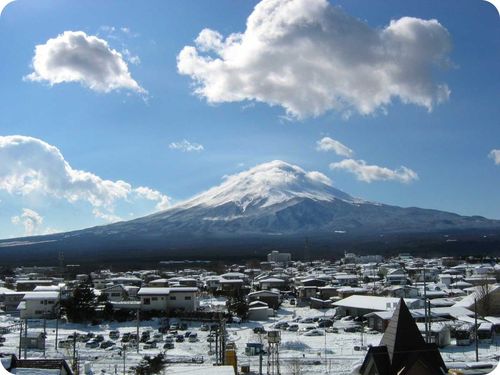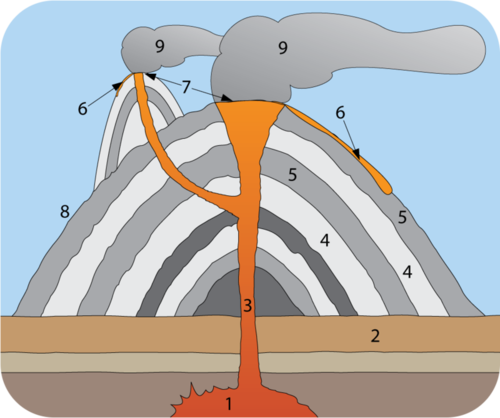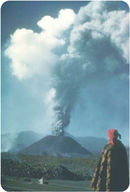49 Types of Volcanoes
A volcano is a vent through which molten rock and gas escape from a magma chamber.
Volcanoes differ in many features such as height, shape, and slope steepness. Some volcanoes are tall cones and others are just cracks in the ground (figure 1). As you might expect, the shape of a volcano is related to the composition of its magma.
Low-viscosity mafic material makes gentle slopes while high-viscous felsic material makes steep slopes of volcano.

Composite (Stratovolcanoes)
Example: Mt. St. Helens (US), Mt. Fuji (Japan), Mt. Vesuvius (Italy)
- Associated with variety of magmas, basaltic to lavas between andesitic and rhyolitic composition
- Higher viscosity and gas content than other volcano types
- Built from a combination of lava flows and pyroclastic deposits
- Have a cone shape with steep slopes
- Explosions more violent and dangerous
Composite volcanoes are made of felsic to intermediate rock. The viscosity of the lava means that eruptions at these volcanoes are often explosive (figure 2).

The viscous lava cannot travel far down the sides of the volcano before it solidifies, which creates the steep slopes of a composite volcano. Viscosity also causes some eruptions to explode as ash and small rocks. The volcano is constructed layer by layer, as ash and lava solidify, one upon the other (figure 3). The result is the classic cone shape of composite volcanoes.

Shield Volcanoes
Shield volcanoes get their name from their shape. Although shield volcanoes are not steep, they may be very large. Shield volcanoes are common at spreading centers or intraplate hot spots (figure 4) and consist of mafic, low-viscous material (basalts).

The lava that creates shield volcanoes is fluid and flows easily. The spreading lava creates the shield shape. Shield volcanoes are built by many layers over time and the layers are usually of very similar composition. The low viscosity also means that shield eruptions are non-explosive.
Main features:
- Largest volcanoes in the world
- Built almost entirely of lava flows
- Gentle (low) slopes
- Associated with basaltic magma: low viscosity, low gas content, non-explosive
- Can form lava tubes underground
Cinder Cones
Cinder Cones
- Small volcanoes
- Built entirely from tephra (usually basalt material)
- Contain small pieces of black or red lava
- Common on larger volcanoes, normal faults, or along cracks and fissures

Cinder cones are the most common type of volcano. A cinder cone has a cone shape, but is much smaller than a composite volcano.
Cinder cones rarely reach 300 meters in height but they have steep sides. Cinder cones grow rapidly, usually from a single eruption cycle (figure 5). Cinder cones are composed of small fragments of rock, such as pumice, piled on top of one another. The rock shoots up in the air and doesn’t fall far from the vent. The exact composition of a cinder cone depends on the composition of the lava ejected from the volcano. It can be felsic or intermediate. Cinder cones usually have a crater at the summit.
Cinder cones are often found near larger volcanoes (figure 6).
 Figure 6. This Landsat image shows the topography of San Francisco Mountain, an extinct volcano, with many cinder cones near it in northern Arizona. Sunset crater is a cinder cone that erupted about 1,000 years ago.
Figure 6. This Landsat image shows the topography of San Francisco Mountain, an extinct volcano, with many cinder cones near it in northern Arizona. Sunset crater is a cinder cone that erupted about 1,000 years ago.Lesson Summary
- Composite, shield, cinder cones, and supervolcanoes are the main types of volcanoes.
- Composite volcanoes are tall, steep cones that produce explosive eruptions.
- Shield volcanoes form very large, gently sloped mounds from effusive eruptions.
- Cinder cones are the smallest volcanoes and result from accumulation of many small fragments of ejected material.
- An explosive eruption may create a caldera, a large hole into which the mountain collapses.
